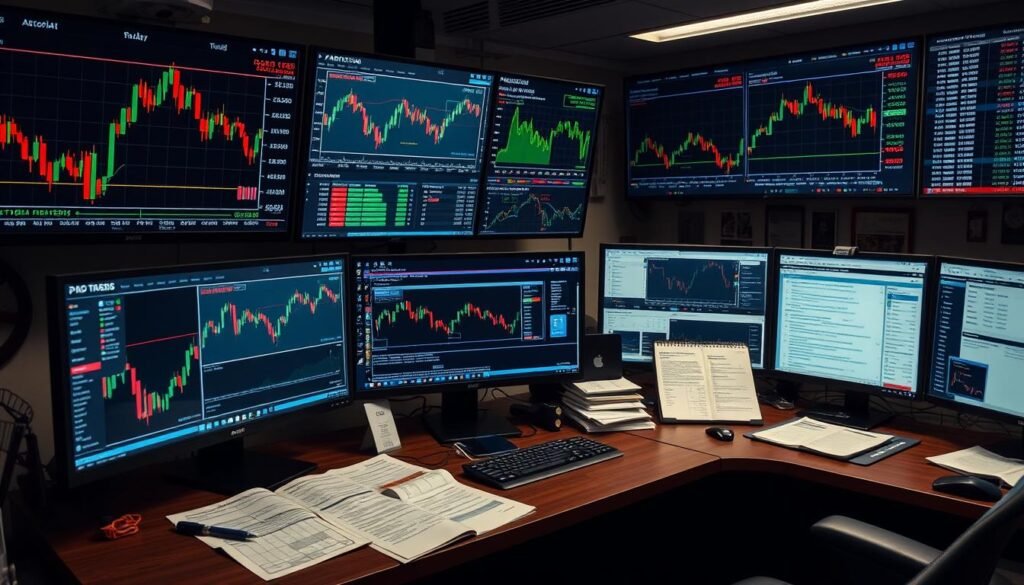Proprietary (prop) trading firms face a world of unpredictable markets every day. They need strong risk management strategies to survive and grow. This guide will show how important it is to manage risk well in prop trading.
In prop trading, planning is key to success. We’ll dive into the world of risk management. You’ll see how careful risk handling is essential for a firm’s success and growth.
Risk management is crucial for a trading firm’s health. It helps keep profits up even when markets are tough. We’ll teach you how to manage risks and protect your capital.
Key Takeaways
- Understanding risk management as a fundamental key to sustainable prop firm success.
- Applying trader risk management to protect and grow trading capital.
- Executing prop trading best practices to navigate volatile markets confidently.
- The symbiosis of risk control techniques and profitability in the trading industry.
- The vital role of solid risk management in asset preservation and loss minimization.
- How cultivating a risk management mindset can lead to more informed trading decisions.
Understanding Prop Firm Trading Dynamics
Prop firm trading is a special area in finance. Here, companies trade to make money, not just to earn commissions. It has its own strategies and risks.
The Nature of Proprietary Trading
In prop firm trading, companies use their own money to trade. They don’t trade for clients. This lets them control their trades and strategies, aiming for big gains.
Prop trading involves complex methods and taking big risks. Knowing the market well is key. Successful traders are good at analyzing and adapting quickly.
Key Characteristics of Successful Prop Traders
Top prop traders know a lot about different financial tools and markets. They use this knowledge and risk management to succeed. Traits like discipline, patience, and decisiveness are important.
- Strong analytical skills to understand market conditions and predict changes.
- High adaptability to quickly change strategies when the market shifts.
- Rigorous discipline to stick to trading plans and risk rules.
- Deep understanding of how to manage risks effectively.
These traits show how complex and rewarding prop trading can be. It’s all about making the most of market chances.
Developing a Solid Risk Management Plan
In the world of proprietary trading, managing risks well is key to growing your business and keeping it safe. A good risk management plan starts with setting clear goals and defining what risks are okay. This way, traders can manage risks that might harm the firm’s finances.
Setting Clear Trading Objectives
Having clear, achievable trading goals is vital for staying on track and measuring success. These goals help guide traders and let them check if they’re making smart choices. It’s important to set goals that are both reachable in the short term and align with long-term plans.
Defining Acceptable Risk Levels
Setting clear risk limits is another key part of managing risks in proprietary trading. These limits help avoid big financial losses and keep traders from taking on too much risk. This approach helps keep the business stable and meets both outside rules and the firm’s own risk tolerance.
| Objective | Risk Level | Implementation Strategy |
|---|---|---|
| Maximize returns on equity trades | Medium | Strict use of stop-loss orders |
| Maintain portfolio diversification | Low | Regular portfolio assessments |
| Limit losses in options trading | High | Leverage caps and time decay management |
By focusing on these key areas, firms can face market uncertainties with more confidence. Good risk management is not just about avoiding losses. It’s also about creating a stable place where traders can grow and help the firm succeed.
Top Risk Management Techniques for Prop Firm Traders
In today’s fast-paced financial markets, it’s key for prop firm traders to know and use risk management tips. These methods not only keep capital safe but also help traders do better. Diversifying, managing risk-to-reward ratios, and using derivatives are top ways to cut down prop trading risks.
Diversification is more than just a basic investment rule for prop traders. It’s a key risk management tool. By investing in different assets, traders can greatly lower risks. Next, keeping a good risk-to-reward ratio means rewards are worth the risks. Lastly, derivatives like options and futures are key for protecting against market ups and downs.
Here’s a table showing how these methods work in prop trading. It highlights their role in managing and reducing trading risks:
| Technique | Description | Benefit |
|---|---|---|
| Diversification | Investing in a variety of assets to reduce risk concentration | Lowers impact of single asset volatility |
| Risk-to-Reward Ratio | Assessing potential gain against possible loss before executing trades | Ensures more deliberate and thoughtful trade execution |
| Derivative Instruments | Using options and futures to hedge existing positions | Provides coverage against adverse market movements |
By using these risk management tips every day, prop firm traders can make their strategies stronger against prop trading risks. Good risk management is more than just keeping capital safe. It helps traders make decisions with more confidence and boldness.
Strategic Trade Sizing for Effective Risk Control
Trade sizing is key in prop trading. It helps traders manage risk and grow their capital. This is especially important in markets that can be very unpredictable.
There are two main trade sizing methods: the fixed fractional method and the Kelly criterion. Each has its own benefits, depending on the trader’s risk level and strategy.
- Fixed Fractional Method: This method risks a set percentage of capital on each trade. It’s simple and works for all levels of traders.
- Kelly Criterion: This method calculates the best risk percentage based on expected returns and win/loss probabilities. It’s all about growing your bankroll while keeping risk low.
Choosing the right trade sizing method is vital for managing risk. It can greatly affect a trader’s success and profitability.
| Trade Sizing Model | Key Feature | Suitable For |
|---|---|---|
| Fixed Fractional | Constant percentage of capital | Conservative traders |
| Kelly Criterion | Risk calculated from win probability | Aggressive traders looking for growth |
Both models help with risk evaluation. But, they should be chosen carefully, considering the trader’s risk tolerance and goals. Good trade sizing is essential for success in prop trading.
Cultivating a Disciplined Trading Mindset
Keeping a disciplined trading mindset is key to success in prop firm trading. It’s about controlling emotions to make smart, planned decisions. This is the base of good trader risk management.
This part talks about how controlling emotions and sticking to a routine help in prop firm trading. By managing emotions, traders can make better, strategic choices. This is crucial in the fast-changing markets.
Emotional Regulation in Trading
Managing emotions is crucial for trader risk management. Emotional highs and lows can lead to quick, wrong decisions. Staying calm helps traders avoid mistakes and stick to their plans.
The Power of Consistency and Routine
Having a consistent trading routine is vital for a reliable trading mindset. It builds discipline, which is the backbone of trading strategies. This routine keeps decisions in line with both short-term goals and long-term success.
Incorporating Stop Losses and Take Profits
In the world of proprietary trading, knowing how to manage risks is key. This includes using risk management strategies and following prop trading best practices. Stop losses and take profits are crucial tools for managing risks and keeping profits safe.
Calculating Optimal Stop Loss Levels
Finding the right stop loss levels is a detailed task. It involves looking at market volatility and how much risk you’re willing to take. By setting stop losses wisely, you can avoid big losses and still have room for profit. It’s best to use technical analysis and real data to set these levels.
Strategies for Setting Take Profits
Stop losses help prevent big losses, while take profits help you lock in gains. To set take profits well, you need to understand market trends and your trade goals. Aim for a balance between risk and reward that fits your trading plan.
To learn more about how prop firms evaluate these techniques, visit this detailed overview. It shows how these methods can work with your trading style.
| Technique | Usage | Benefits |
|---|---|---|
| Stop Loss | Limit loss to predefined amount | Protects trading capital |
| Take Profit | Secure profits at target levels | Locks in profit, prevents reversal loss |
Using these risk management strategies in prop trading is more than just protecting your money. It’s about making every trade count. Understanding and using these strategies are key to success in trading.
Utilizing Hedging Strategies in Prop Trading
In the world of proprietary trading, managing prop trading risks is key. Using hedging strategies is a top way to reduce these risks. Hedging helps protect investments by taking a position in a related asset when the market moves unexpectedly.
Hedging is vital in prop trading, where big financial losses are a risk. Traders can use various hedging methods to protect their portfolios from big losses.
- Derivatives: Options, futures, and swaps are strong hedging tools. They let traders secure prices or exchange rates before transactions, protecting them from market changes.
- Diversification: Investing in different assets is another risk-reducing strategy. By spreading investments across various asset classes, traders can balance losses with gains.
Hedging can greatly lower prop trading risks, but it has its own challenges and costs. It’s important for traders to weigh the costs of hedging and how it fits with their investment goals and risk tolerance.
Using hedging strategies well can make a prop trading portfolio safer and more successful. It requires knowing the instruments and market conditions well to time and use hedges effectively.
Continuous Risk Assessment and Review Process
In the fast-paced world of proprietary trading, continuous risk assessment is key. It helps traders keep up with changing market conditions. This process keeps prop trading strategies effective and protects investments from sudden market changes.
Techniques for Monitoring Market Conditions
Monitoring market conditions requires both numbers and insights. Traders use real-time data to follow market trends. They also use advanced analytics to spot patterns that guide their trading choices.
Adjusting Strategies in Response to Volatility
Volatility is a big part of trading that needs quick and smart strategy changes. By using strong prop trading strategies and continuous risk assessment, traders stay flexible. They adjust their plans to match the current market.
| Strategy Element | Importance in Risk Assessment | Tools for Implementation |
|---|---|---|
| Real-time Data Analysis | High | Trading software with live feeds |
| Volatility Assessment | Critical | Volatility indices, proprietary algorithms |
| Strategy Adjustment | Mandatory | Scenario analysis, real-time simulations |
Keeping prop trading strategies in sync with market trends through continuous risk assessment boosts profits. It also cuts down on risks, creating a strong trading environment.
Enhancing Decision-Making with Technical Analysis
Technical analysis is key for many traders. It helps them understand market trends and predict price changes.
Key Indicators for Prop Traders to Monitor
Technical indicators are the heart of technical analysis. They help traders spot market trends and make better choices. Tools like moving averages, RSI, and MACD are essential. They show trend directions and momentum, guiding daily trading decisions.
Chart Patterns and Trade Signal Recognition
Chart patterns are vital for spotting trade signal recognition. Shapes like head and shoulders, cups and handles, and triangles hint at market shifts. When paired with indicators, they form strong trading plans.
Using chart patterns and indicators together boosts traders’ decision-making. This can lead to better returns and risk management.
Leveraging Fundamental Analysis for Risk Management
In prop firm trading, fundamental analysis is key for a strong risk management plan. It looks at economic factors that affect asset values, unlike technical analysis which focuses on price trends. This approach helps traders understand how economic indicators, earnings reports, and central bank decisions can change the market.
By using fundamental analysis, prop traders can see an asset’s true value and predict market trends. This analysis is wide-ranging, covering big economic trends and the financial details of companies.

- Economic Data Releases: These include employment rates, GDP growth figures, and inflation data—info that directly impacts exchange rate movements and commodity prices.
- Earnings Reports: Vital for stock traders, these reports offer insights into a company’s profitability and operational efficiency, thereby influencing stock buying or selling decisions.
- Policy Decisions: Interest rate changes and fiscal policies, set by governments or central banks, can significantly alter market landscapes and trading strategies.
| Economic Indicator | Impact on Markets | Relevance to Prop Firm Trading |
|---|---|---|
| GDP Growth Rate | Rises in GDP positive for currency strength | Essential for forex traders |
| Corporate Earnings Growth | Positive earnings lead to bullish stock markets | Directly impacts stock selection strategies |
| Interest Rate Changes | Adjustment leads to currency appreciation or depreciation | Critical for decisions in forex and bond trading |
Successful prop firm trading needs more than just chart-reading skills. It also requires understanding how global events and economic data affect markets. By combining fundamental analysis with technical tools, traders can make a detailed risk management plan. This plan is ready for both short-term and long-term market changes.
Diversification of Trades to Minimize Unsystematic Risk
In the world of prop trading, managing risk is key. The diversification of trades is a top strategy for handling unsystematic risk. By investing in different areas, traders protect their money from sudden market changes. This makes their performance more stable.
Different Approaches to Portfolio Diversification
Creating a strong trading portfolio means having a mix of assets. Traders use stocks, bonds, commodities, and foreign exchange to balance their portfolio. Each type of investment reacts differently to market changes, making diversification vital for reducing risk.
Risk Reduction Through Cross-Asset Correlations
Knowing how different assets relate to each other is crucial. It helps build a portfolio that can handle market ups and downs. For example, if one market does poorly, another might do well, balancing the portfolio. By studying past performance and how assets relate, traders can spread their risk wisely.
| Asset Class | Typical Reaction to Market Volatility | Role in Diversification |
|---|---|---|
| Stocks | Highly sensitive | Grow capital, potential high returns |
| Bonds | Moderately sensitive | Lower risk, stable income |
| Commodities | Varied sensitivity | Hedge against inflation |
| Foreign Exchange | Specific sensitivity due to geopolitical factors | Diversification across currencies |
Position Management Throughout the Trade Lifecycle
In the fast-paced world of proprietary trading, effective position management is key. It helps traders navigate the trade lifecycle complexities. By managing entry, adjustments, and exits well, traders can reduce risks. Let’s explore how to use these risk mitigation techniques for better trading results.
Entry Techniques and Position Adjustment
Starting a trade at the right time and place is crucial. It can greatly impact a trade’s profit and risk. Good position management starts with understanding market conditions and finding the best entry point. This requires thorough market analysis and knowledge of market trends that affect prices.
After entering a trade, adjustments might be needed. This could mean scaling up or down based on market changes or new information.
Trade Exit Strategies for Risk Mitigation
Knowing when to exit a trade is just as important as when to enter. Good exit strategies help keep gains and limit losses. This makes position management throughout the trade lifecycle very important. Using stop-loss orders and setting target levels are common ways to define exit points.
Linking these strategies to real-time market analysis and events helps traders respond quickly. This improves risk mitigation techniques.
In conclusion, managing positions well through planned entry and exit strategies is crucial in prop trading. By refining these strategies, traders can better manage risks and improve their trading performance.
| Technique | Application | Effect on Risk |
|---|---|---|
| Strategic Entry Timing | Synchronizing entry with optimal market conditions | Reduces potential downside |
| Position Adjustment | Adapting to market changes during the trade | Enhances flexibility and control over the trade |
| Defined Exit Strategy | Using stop-loss and target levels to solidify exits | Secures profits and limits losses |
Understanding Leverage and Its Impact on Risk
Leverage in trading can greatly increase your returns, but it also ups the risk. It’s key to manage leverage well to improve your trading. This part will look into leverage’s role and how to handle its risks in your trading.
Navigating Leverage to Optimize Trading Performance
Using leverage well means knowing the market and your risk level. It lets you trade more than your initial money, boosting potential gains. But, to avoid big risks, you need solid risk management plans that fit your goals.
How to Avoid Common Pitfalls of Overleveraging
To avoid the dangers of too much leverage, keep a tight grip on your margin and watch market changes closely. Here are some tips:
- Always check your leverage ratio to match the asset’s volatility and liquidity.
- Use stop-loss orders to limit losses and keep your capital safe in tough markets.
- Do scenario analysis to see possible losses in the worst market scenarios.
Following these steps helps you use leverage’s benefits without facing big financial losses.
Prop Trading Best Practices and Mindful Risk Taking
In prop trading, success is all about finding the right balance. It’s about being bold yet careful with mindful risk taking. Good risk management means avoiding losses and aiming for big wins. This is done by following prop trading best practices and staying updated with continuous education.
Learning from Historical Trade Analysis
Improving trading strategies starts with learning from the past. Historical trade analysis gives deep insights into market trends and risks. It helps traders make smart moves based on past successes and failures.
The Role of Mentorship and Continuous Education in Risk Management
Staying updated in trading is key, going beyond just books and classes. Mentorship is especially important. Experienced traders share crucial knowledge like the mental side of trading and how to handle risks. This knowledge is vital for mindful risk taking.
These factors help traders manage risks well and seize chances in fast markets. They are essential for success in prop trading.
Technology and Tools for Trader Risk Management
Technology has changed how prop traders work, making things more efficient and based on data. Today, the right tech gives traders the tools they need to keep their risks under control. This includes precise analytics, real-time data, and automated systems.
Software Solutions for Trade Execution and Monitoring
Software for trade execution and monitoring is key for managing risks. It lets traders automate trades, set risk limits, and watch their activities live. This reduces mistakes and ensures strategies are followed.
The Importance of Reliable Data in Risk Management
Having reliable, up-to-date data is vital for managing risks. Traders use this data to make fast, informed choices. This has made advanced analytics tools more important, helping to spot risks and chances.

The link between trading tech and risk management tools is getting stronger. Traders who use these tools well can better manage risks. This helps them succeed in proprietary trading over time.
Evaluating Risk Management Strategies Against Performance Metrics
In the world of prop trading, evaluating risk management strategies is key. This is done through strong performance metrics. We will look at the Key Performance Indicators (KPIs) prop traders should watch. We’ll also see how analytics can help improve risk management.
Key Performance Indicators (KPIs) for Prop Traders
Performance metrics act as a guide for traders. They show both strengths and areas for growth. KPIs like Drawdown, Sharpe Ratio, and Profit Factor are vital for evaluating risk management.
- Drawdown – Shows the biggest drop in a trader’s capital, helping understand risk.
- Sharpe Ratio – Compares return to risk, showing the balance between reward and risk.
- Profit Factor – Looks at profits versus losses, a simple way to check trading success.
These KPIs help see if the risk taken matches the returns. This is key for lasting trading success.
Using Analytics to Fine-Tune Risk Management Techniques
Analytical tools are crucial for improving risk management. By constantly checking performance metrics, traders can adjust their strategies quickly.
| Tool | Function | Benefit |
|---|---|---|
| Automated Trading Systems | Executes trades based on set rules | Reduces emotional trading, boosts consistency |
| Backtesting Software | Tests strategies with past data | Finds strategy flaws before live use |
| Real-time Analytics Platforms | Analyses market and performance live | Helps adapt quickly to market changes |
With these tools, prop traders can keep their risk management fresh. They can always evaluate and improve their strategies with solid performance metrics.
Building a Comprehensive Risk Management Framework
Creating a strong risk management plan is key for proprietary trading success. This plan acts as a guide for tackling trading challenges and adapts to market changes. It combines various risk strategies to help traders deal with market ups and downs. This keeps the firm’s capital safe and ensures long-term success.
This risk management framework is always evolving. It needs regular checks and quick changes to keep up with the financial world. Using many risk strategies, like trade sizing and advanced analytics, is crucial. It helps make every trading decision align with the firm’s goals. Prop trading firms that focus on risk management stand out, setting high standards in the industry.
Building a strong risk management culture is essential. It helps prevent losses and seize opportunities with confidence. For prop trading firms, risk management is not just a goal but a key to lasting success. A comprehensive risk management framework is vital for thriving in the fast-paced world of proprietary trading.












